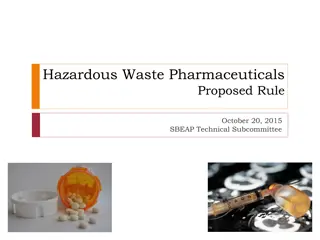Understanding Biohazardous Waste Management
Biohazardous waste poses a threat to living organisms, particularly humans, due to biological hazards like medical waste or toxins. This waste includes categories such as solid, liquid, sharps, and pathological waste, each requiring proper segregation and disposal to minimize health risks. Learn about biohazards, waste categories, handling techniques, and special considerations for disposal. Stay informed to ensure safe management of biohazardous materials.
Download Presentation

Please find below an Image/Link to download the presentation.
The content on the website is provided AS IS for your information and personal use only. It may not be sold, licensed, or shared on other websites without obtaining consent from the author. Download presentation by click this link. If you encounter any issues during the download, it is possible that the publisher has removed the file from their server.
E N D
Presentation Transcript
Biohazards Biohazards Definition: Biological substances that pose a threat to the health of living organisms, primarily that of humans. Biohazards ------------- biological hazards Examples medical waste or samples of a microorganisms, virus toxin (from a biological source) -------- human health
Biohazardous Biohazardous materials materials Transgenic Plants, Animals, virus, bacteria, fungi and Insects
Biohazardous Biohazardous waste categories waste categories Main Four categories 1. Solid Biohazardous waste 2. Liquid Biohazardous waste 3. Biohazardous sharps waste 4. Pathological waste Each form must be segregated, identified, decontaminated and disposed of in an appropriate manner in order to minimize risks
1. Solid Solid Biohazardous Biohazardous waste (non waste (non- -sharps) sharps) Gloves and other disposable PPE contaminated with culture material Plasticware (pipettes or pipette tips, culture plates, specimen vials) Cont. bacterial and cell culture material Towels and bench paper All culture or sample containers that are contaminated with biological materials Vials of blood (glass blood vials -------break easily --------- as sharps waste)
Storage Storage leak-proof container lined with an autoclave bag of moderate thickness Container ----------lid Container ------- labeled -------- biohazard symbol Bench top containers (Small plastic containers) --------- suitable-----For small quantities of contaminated dry goods (pipette tips, centrifuge tubes) Biohazard Bin Daily disposal of ------- into a larger container strongly recommended.
Wastes Requiring Special Considerations Breakable Biohazardous Wastes tubes of blood ------- create trouble treated as ------sharp waste Serological pipettes All plastic pipettes------------ segregated ----- puncture
Treatment and Disposal Treatment and Disposal The purpose of solid biohazardous waste treatment is biological inactivation in a manner that reduces hazardous exposure risk for lab workers and the environment. This is generally achieved by autoclave treatment of waste or treatment and disposal through a medical waste disposal contractor who will autoclave or incinerate the waste.
2. Liquid Liquid Biohazardous Biohazardous waste waste bulk quantities of blood, blood products, body fluids from human and animal research contaminated culture media If less 25ml -------solid waste Storage Closed, leak proof containers Collection vessels ------ must be In a bucket or deep tray Labeled Vacuum Flask
Treatment and Disposal Treatment and Disposal Chemical treatment of liquids with disinfectant; disposal via lab sink Disinfectants --- used for treatment of liquid biological waste. Add household bleach ---- makes 10% of final volume ---- at least 30 min. Discard the mixture -------- lab sink. Rinse down the sink with water. splash goggles, gloves, and a lab coat for handling of bleach Autoclave treatment of liquids; disposal via lab sink Place the collection vessel in a secondary container and autoclave. Treat by autoclave using the liquids cycle. Discard through lab sink. loose the lid on the vessel before placing in autoclave
3. Biohazardous Biohazardous sharps waste sharps waste Any device that is sharp enough to puncture the skin ------- contaminated with a biological material that is an infectious disease transmission risk. Examples Needles, disposable syringes capillary tubes scalpels Microscope slides Pasteur pipettes Small glass/broken tubes of blood cultures
Storage Specifically designed container constructed of puncture-resistant material leak-proof on the sides and bottom marked -------- biohazard symbol has a restricted opening to prevent Sharps Container items from coming back out of the container, and to prevent someone from sticking their hand inside.
Treatment and Disposal Treatment and Disposal Medical Waste disposal Contractor Departments ----- contract for pickup and disposal of waste Sharps containers must be permanently closed and wiped down with a disinfectant prior to removal from the lab and for disposal If any liquids ------------ biohazardous sharps container, it must be placed in a leak-proof secondary container with a secure lid
4. 4. Pathological waste Pathological waste all unfixed human organs, tissues and body parts unfixed animal tissues carcass Storage, Treatment and Disposal double-bagged in biohazard bags -------- Symbol Stored --------- minimize the release of fluids during handling Storage of bags in a tray, or secondary storage of bags in a plastic zipper bag ----------------- strongly recommended. A medical waste disposal contractor ----------- pickup and disposal























